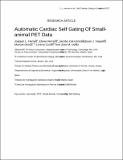| dc.contributor.author | Herraiz, Joaquin L. | |
| dc.contributor.author | Herranz, Elena | |
| dc.contributor.author | Cal-González, Jacobo | |
| dc.contributor.author | Vaquero, Juan J. | |
| dc.contributor.author | Desco, Manuel | |
| dc.contributor.author | Cussó, Lorena | |
| dc.contributor.author | Udias, Jose M. | |
| dc.date.accessioned | 2016-06-23T20:35:39Z | |
| dc.date.available | 2016-06-23T20:35:39Z | |
| dc.date.issued | 2015-06 | |
| dc.identifier.issn | 1536-1632 | |
| dc.identifier.issn | 1860-2002 | |
| dc.identifier.uri | http://hdl.handle.net/1721.1/103303 | |
| dc.description.abstract | Purpose
The cardiac gating signal (CGS) in positron emission tomography (PET) studies is usually obtained from an electrocardiography (ECG) monitor. In this work, we propose a method to obtain the CGS in small-animal PET using the acquired list-mode data without using any hardware or end-user input.
Procedures
The CGS was obtained from the number of coincidences over time acquired in the lines-of-response connected with the cardiac region. This region is identified in the image as its value changes with frequencies in the range of 3 to 12 Hz. The procedure was tested in a study with 29 Wistar rats and 6 mice injected with 2-deoxy-2-[[superscript 18]F]fluoro-d-glucose, which underwent a 45-min single-bed list-mode PET scan of the heart syncronized with an ECG. The estimated signals and the reconstructed images using eight-gated frames were compared with the ones obtained using the ECG signal from the monitor.
Results
The differences of the PET-based CGS with respect to the ECG relative to the duration of the heartbeats were 5.6 % in rats and 11.0 % in mice. The reconstructed gated images obtained from the proposed method do not differ qualitatively with respect to the ones obtained with the ECG. The quantitative analysis of both set of images were performed measuring the volume of the left ventricle (LV) of the rats in the end-of-systole and end-of-diastole phase. The differences found in these parameters between both methods were below 12.1 % in the ESV and 9.3 % in the EDV with a 95 % confidence interval, which are comparable to the accuracy (7 %) of the method used for segmenting the LV.
Conclusion
The proposed method is able to provide a valid and accurate CGS in small-animal PET list-mode data. | en_US |
| dc.description.sponsorship | Consejería de Educación, Juventud y Deporte de la Comunidad de Madrid (Spain) | en_US |
| dc.description.sponsorship | Madrid-MIT M+Vision Consortium | en_US |
| dc.description.sponsorship | Comunidad de Madrid (S2013/MIT-3024 TOPUS-CM) | en_US |
| dc.description.sponsorship | Universidad Carlos III de Madrid (Grupos UCM, 910059) | en_US |
| dc.description.sponsorship | Programa Consolider-Ingenio 2010, Spain (Consolider-Ingenio 2010, CSPD-2007-00042) | en_US |
| dc.description.sponsorship | Spain. Ministerio de Economía y Competitividad (RD12/0042/0057) | en_US |
| dc.description.sponsorship | Spain. Ministerio de Ciencia e Innovación (ENTEPRASE grant, PSE-300000-2009-5 and TEC2007-64731/TCM) | en_US |
| dc.description.sponsorship | European Union. European Regional Development Fund | en_US |
| dc.description.sponsorship | RIC-RETIC network | en_US |
| dc.publisher | Springer US | en_US |
| dc.relation.isversionof | http://dx.doi.org/10.1007/s11307-015-0868-y | en_US |
| dc.rights | Article is made available in accordance with the publisher's policy and may be subject to US copyright law. Please refer to the publisher's site for terms of use. | en_US |
| dc.source | Springer US | en_US |
| dc.title | Automatic Cardiac Self-Gating of Small-Animal PET Data | en_US |
| dc.type | Article | en_US |
| dc.identifier.citation | Herraiz, Joaquin L., Elena Herranz, Jacobo Cal-González, Juan J. Vaquero, Manuel Desco, Lorena Cussó, and Jose M. Udias. “Automatic Cardiac Self-Gating of Small-Animal PET Data.” Molecular Imaging and Biology 18, no. 1 (June 9, 2015): 109–116. | en_US |
| dc.contributor.department | Madrid-MIT M+Vision Consortium | en_US |
| dc.contributor.department | Massachusetts Institute of Technology. Research Laboratory of Electronics | |
| dc.contributor.mitauthor | Herraiz, Joaquin L. | en_US |
| dc.relation.journal | Molecular Imaging and Biology | en_US |
| dc.eprint.version | Author's final manuscript | en_US |
| dc.type.uri | http://purl.org/eprint/type/JournalArticle | en_US |
| eprint.status | http://purl.org/eprint/status/PeerReviewed | en_US |
| dc.date.updated | 2016-05-23T12:17:27Z | |
| dc.language.rfc3066 | en | |
| dc.rights.holder | World Molecular Imaging Society | |
| dspace.orderedauthors | Herraiz, Joaquin L.; Herranz, Elena; Cal-González, Jacobo; Vaquero, Juan J.; Desco, Manuel; Cussó, Lorena; Udias, Jose M. | en_US |
| dspace.embargo.terms | N | en |
| dc.identifier.orcid | https://orcid.org/0000-0001-7208-8863 | |
| mit.license | PUBLISHER_POLICY | en_US |
